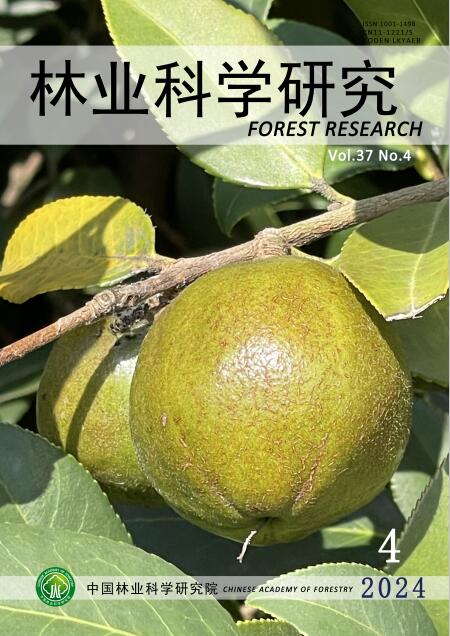Effects of Drought Disturbance on Forest Biomass in Southwestern China
Q4 Agricultural and Biological Sciences
引用次数: 1
Abstract
Forest growth is easily influenced and disturbed by extreme climate change. Exploring the spatial and temporal changes of forest biomass and its response to climate change is of significant importance to assess the carbon dynamics of terrestrial ecosystem. During 2009-2012, continuous severe drought happened in southwestern China, and large-scale extreme drought occurred in 2009 and 2010. Although previous studies have revealed the responses of vegetation to the drought in southwestern China, there is no study on quantifying the effects of drought disturbance on forest biomass. In this study, annual forest Biomass Carbon Density (BCD) was estimated first using forest resources statistics of China (1984-2013), the Global Inventory Modeling and Mapping Studies (GIMMS) Normalized Difference Vegetation Index (NDVI) and elevation data in southwestern China. Then the effects of drought disturbance on forest biomass were evaluated through correlation analysis combined with the Palmer Drought Severity Index (PDSI) data. The results showed that: (1) the accuracy of forest BCD was enhanced by using Inventory-satellite-based method, and the accuracy reached R2=0.86 (P<0.001); (2) from 2000 to 2013, the mean BCD in southwestern China was 38.66 Mg C/ha, and was increasing annually with rate of 0.102 Mg C/ha; (3) forest BCD continuously declined due to the drought from 2010 to 2012, and in the extreme drought year 2010, BCD anomaly reduced to -1.004 and returned to 0.371 in 2013. Our results indicate that drought disturbances could significantly impact the forest biomass and the carbon dynamics of terrestrial ecosystem.干旱干扰对西南地区森林生物量的影响
森林生长容易受到极端气候变化的影响和干扰。研究森林生物量的时空变化及其对气候变化的响应,对评估陆地生态系统碳动态具有重要意义。2009-2012年西南地区持续发生严重干旱,2009年和2010年发生了大规模极端干旱。尽管已有研究揭示了西南地区植被对干旱的响应,但尚未有研究量化干旱干扰对森林生物量的影响。本文首先利用中国森林资源统计数据(1984-2013)、全球植被清查模型与制图研究(GIMMS)、归一化植被指数(NDVI)和西南高程数据估算了中国森林年生物量碳密度(BCD)。然后结合Palmer干旱严重指数(PDSI)数据,通过相关分析评价干旱干扰对森林生物量的影响。结果表明:(1)基于卫星清查的森林生物多样性调查方法提高了森林生物多样性调查的精度,准确度达到R2=0.86 (P<0.001);(2) 2000—2013年,西南地区平均BCD为38.66 Mg C/ha,呈逐年递增趋势,增幅为0.102 Mg C/ha;(3) 2010 ~ 2012年受干旱影响,森林BCD持续下降,在极端干旱年2010年,BCD异常降至-1.004,2013年恢复到0.371。研究结果表明,干旱干扰会显著影响森林生物量和陆地生态系统的碳动态。
本文章由计算机程序翻译,如有差异,请以英文原文为准。
求助全文
约1分钟内获得全文
求助全文
来源期刊

林业科学研究
Environmental Science-Ecology
CiteScore
0.90
自引率
0.00%
发文量
4834
期刊介绍:
Forestry Research is a comprehensive academic journal of forestry science organized by the Chinese Academy of Forestry. The main task is to reflect the latest research results, academic papers and research reports, scientific and technological developments and information on forestry science mainly organized by the Chinese Academy of Forestry, to promote academic exchanges at home and abroad, to carry out academic discussions, to flourish forestry science, and to better serve China's forestry construction.
The main contents are: forest seeds, seedling afforestation, forest plants, forest genetic breeding, tree physiology and biochemistry, forest insects, resource insects, forest pathology, forest microorganisms, forest birds and animals, forest soil, forest ecology, forest management, forest manager, forestry remote sensing, forestry biotechnology and other new technologies, new methods, and to increase the development strategy of forestry, the trend of development of disciplines, technology policies and strategies, etc., and to increase the forestry development strategy, the trend of development of disciplines, technology policies and strategies. It is suitable for scientists and technicians of forestry and related disciplines, teachers and students of colleges and universities, leaders and managers, and grassroots forestry workers.
 求助内容:
求助内容: 应助结果提醒方式:
应助结果提醒方式:


